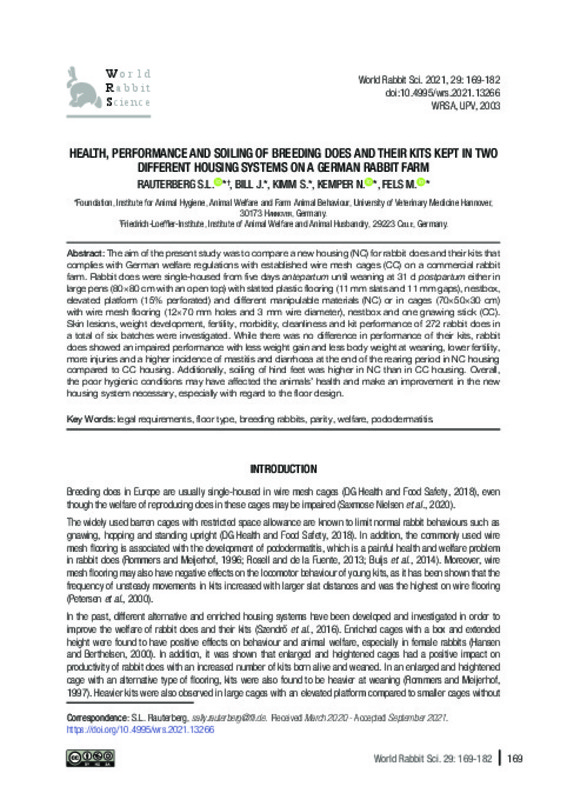JavaScript is disabled for your browser. Some features of this site may not work without it.
Buscar en RiuNet
Listar
Mi cuenta
Estadísticas
Ayuda RiuNet
Admin. UPV
Health, performance and soiling of breeding does and their kits kept in two different housing systems on a German rabbit farm
Mostrar el registro sencillo del ítem
Ficheros en el ítem
| dc.contributor.author | Rauterberg, Sally Luisa
|
es_ES |
| dc.contributor.author | Bill, Joana
|
es_ES |
| dc.contributor.author | Kimm, Sarah
|
es_ES |
| dc.contributor.author | Kemper, Nicole
|
es_ES |
| dc.contributor.author | Fels, Michaela
|
es_ES |
| dc.date.accessioned | 2021-10-01T10:06:55Z | |
| dc.date.available | 2021-10-01T10:06:55Z | |
| dc.date.issued | 2021-09-30 | |
| dc.identifier.issn | 1257-5011 | |
| dc.identifier.uri | http://hdl.handle.net/10251/173616 | |
| dc.description.abstract | [EN] The aim of the present study was to compare a new housing (NC) for rabbit does and their kits that complies with German welfare regulations with established wire mesh cages (CC) on a commercial rabbit farm. Rabbit does were single-housed from five days antepartum until weaning at 31 d postpartum either in large pens (80×80 cm with an open top) with slatted plastic flooring (11 mm slats and 11 mm gaps), nestbox, elevated platform (15% perforated) and different manipulable materials (NC) or in cages (70×50×30 cm) with wire mesh flooring (12×70 mm holes and 3 mm wire diameter), nestbox and one gnawing stick (CC). Skin lesions, weight development, fertility, morbidity, cleanliness and kit performance of 272 rabbit does in a total of six batches were investigated. While there was no difference in performance of their kits, rabbit does showed an impaired performance with less weight gain and less body weight at weaning, lower fertility, more injuries and a higher incidence of mastitis and diarrhoea at the end of the rearing period in NC housing compared to CC housing. Additionally, soiling of hind feet was higher in NC than in CC housing. Overall, the poor hygienic conditions may have affected the animals’ health and make an improvement in the new housing system necessary, especially with regard to the floor design. | es_ES |
| dc.description.sponsorship | This study was funded by the Agricultural European Innovation Partnership (EIP-AGRI) in a framework of the project “Rawecoh-Le”. The authors wish to thank the participating farm staff and colleagues for their assistance, and especially Harald Ulbrich and Kai Göbel for their technical support in data collection. | es_ES |
| dc.language | Inglés | es_ES |
| dc.publisher | Universitat Politècnica de València | es_ES |
| dc.relation.ispartof | World Rabbit Science | es_ES |
| dc.rights | Reconocimiento - No comercial - Compartir igual (by-nc-sa) | es_ES |
| dc.subject | Legal requirements | es_ES |
| dc.subject | Floor type | es_ES |
| dc.subject | Breeding rabbits | es_ES |
| dc.subject | Parity | es_ES |
| dc.subject | Welfare | es_ES |
| dc.subject | Pododermatitis | es_ES |
| dc.title | Health, performance and soiling of breeding does and their kits kept in two different housing systems on a German rabbit farm | es_ES |
| dc.type | Artículo | es_ES |
| dc.rights.accessRights | Abierto | es_ES |
| dc.description.bibliographicCitation | Rauterberg, SL.; Bill, J.; Kimm, S.; Kemper, N.; Fels, M. (2021). Health, performance and soiling of breeding does and their kits kept in two different housing systems on a German rabbit farm. World Rabbit Science. 29(3):169-182. http://hdl.handle.net/10251/173616 | es_ES |
| dc.description.accrualMethod | OJS | es_ES |
| dc.description.upvformatpinicio | 169 | es_ES |
| dc.description.upvformatpfin | 182 | es_ES |
| dc.type.version | info:eu-repo/semantics/publishedVersion | es_ES |
| dc.description.volume | 29 | es_ES |
| dc.description.issue | 3 | es_ES |
| dc.identifier.eissn | 1989-8886 | |
| dc.relation.pasarela | OJS\13266 | es_ES |
| dc.contributor.funder | Agricultural European Innovation Partnership (EIP-AGRI) | es_ES |






